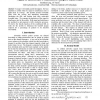Free Online Productivity Tools
i2Speak
i2Symbol
i2OCR
iTex2Img
iWeb2Print
iWeb2Shot
i2Type
iPdf2Split
iPdf2Merge
i2Bopomofo
i2Arabic
i2Style
i2Image
i2PDF
iLatex2Rtf
Sci2ools
GLOBECOM
2006
IEEE
2006
IEEE
Signal to Interference Prediction for Adaptive Radio Links
: To improve downlink packet throughput, the base schedules a mobile when its signal to interference ratio is higher than on average. The mobiles measure downlink pilots from the serving and interfering basestations, calculating the SIR, and feeding back their achievable downlink rates. We examine the prediction of the signal to interference ratio by the mobile. Both signal and interference are modeled as auto-regressive (AR) stochastic processes. We derive the density function of the conditional SIR, in order for the mobile to determine the backoff margin required for a percentage of packets to be decoded successfully.
| Added | 11 Jun 2010 |
| Updated | 11 Jun 2010 |
| Type | Conference |
| Year | 2006 |
| Where | GLOBECOM |
| Authors | Jonathan Ling, Ufuk Tureli |
Comments (0)

